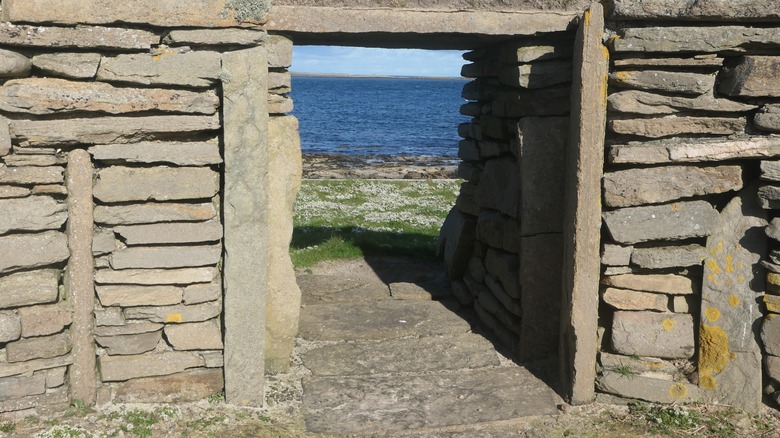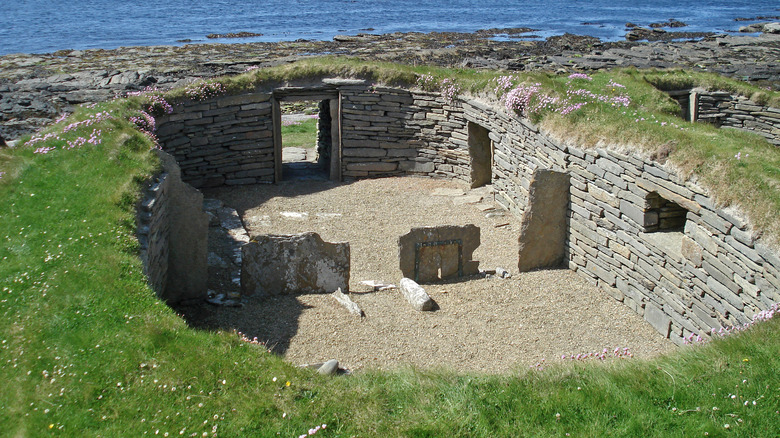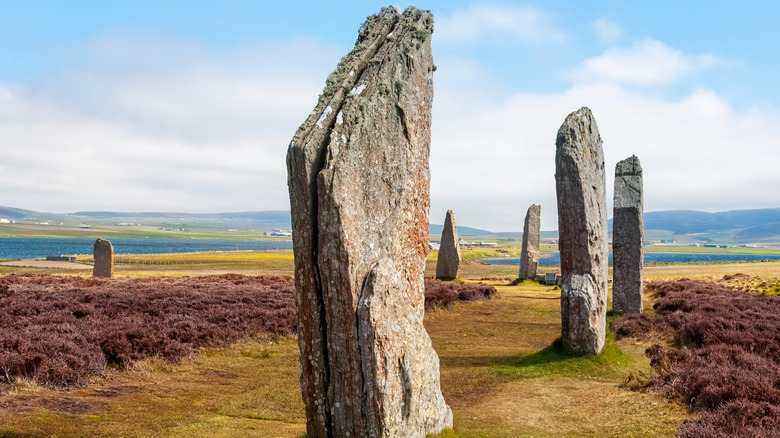This 6,000-Year-Old UK Home Is So Ancient That It Has Stone Furniture
On windswept Papa Westray, one of the Orkney Islands north of the Scottish mainland, one of the oldest houses in Europe looks out onto the freezing sea. It's the called Knap of Howar, a proper house: That's the front door in the photo above. Its two, unconnected rooms have cupboards, a hearth, and even benches hewn with care from the soft Orkney sandstone. The official website of the Orkney Islands dates them to about 3800 B.C. That's older than it sounds. It was likely before the domestication of the horse (via Smithsonian). The plow had not yet been invented (via National Museums Scotland). In faraway Mesopotamia, people were just beginning to record their thoughts in writing (per Getty).
Venerable Bede, a medieval British historian, assumed that the world was brand new in 3800 B.C., barely 150 years old, as the Linda Hall Library explains. To us, looking back on this remote moment, he might as well have been right. But to the men who quarried, dressed, and laid the stones of the Knap, and the farming families who warmed their hands by its fireplace and had to wash up and take out the garbage, it wasn't a relic at all. It was home.
The tale of the oyster shell
The Knap of Howar may be old, but we haven't known about it for very long. According to Archaeology Orkney, a landowner on the island of Papa Westray named William Traill came across what seemed to be an underground building by the beach in 1930. He invited the antiquarian William Kirkness to help him dig the house out of the sand. Initially, the men thought the house had been built by the ancient Picts, but excavations in the 1970s proved that it was much older. These later excavations would find remains of wooden structures and farmland around the house.
One thing that Traill and Kirkness noticed was the midden heap, the house's garbage dump. It was full of shells: oysters, razorbacks, scallops, and other delicacies of the sea. They were probably a staple of the local diet. They were also impossible to source on Papa Westray. Oysters require a calm, shallow bay to grow in numbers necessary to feed a family. Papa Westray's beach has no such protected shallows, which meant the landscape of the island had probably changed dramatically since people lived in the Knap. Today, scientists are looking into these oyster shells for more subtle, quantitative data. For example, can we tell the season in which they were harvested? Can we tell the temperature of the waters from which they were plucked?
The women who captured an island
The Knap of Howar is one of many Neolithic ruins found around the Orkney Islands; others include chambered, underground tombs, as well as mysterious rings of monumental stones like England's Stonehenge. UNESCO says that while many of the ruins remain unexplored, they suggest a "dynamic" and sophisticated culture.
How did people get to these remote, forbidding islands? And why? According to the Guardian, Stone Age farmers first arrived on these chilly shores from mainland Scotland, bringing pigs, sheep, cattle, and grain seeds in their boats. It's not clear why they came, but their lives were rough: Few adults lived past their 30s. Nevertheless, they had a complex spiritual tradition, with funeral rites and communal feasts. They also had an aesthetic sense that defies our caveman stereotypes: We know that they painted many of their buildings, for example.
Whoever these people were, a wave of migration in the Bronze Age changed their culture completely. The newcomers, according to the University of Edinburgh, were mostly women. Probably in flight from climate change, these women kept coming for generations, marrying local men. They would eventually absorb the natives, ending the era of the Knap of Howar forever.


